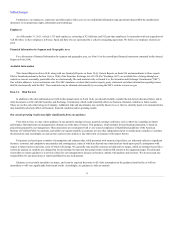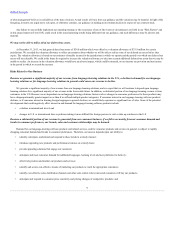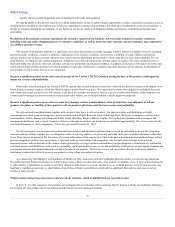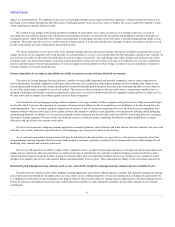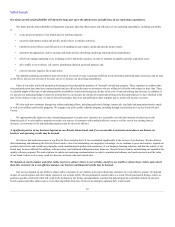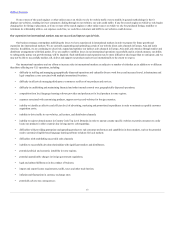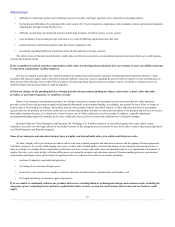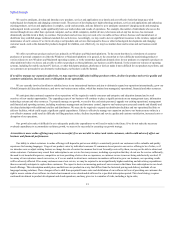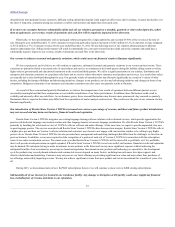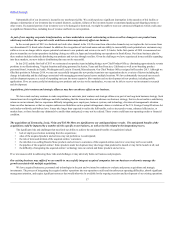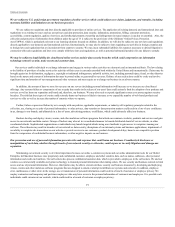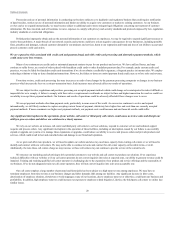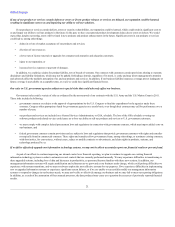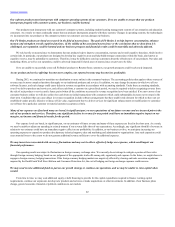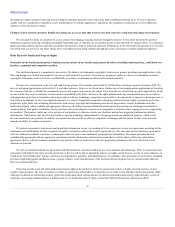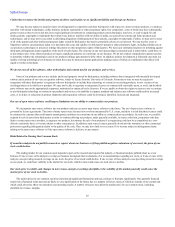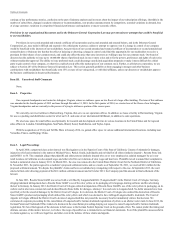Rosetta Stone 2013 Annual Report Download - page 19
Download and view the complete annual report
Please find page 19 of the 2013 Rosetta Stone annual report below. You can navigate through the pages in the report by either clicking on the pages listed below, or by using the keyword search tool below to find specific information within the annual report.
Table of Contents
Challenges and risks from such investments and acquisitions include:
•negative effects on products and product pipeline from the changes and potential disruption that may follow the acquisition;
•diversion of our management’s attention away from our business;
•declining employee morale and retention issues resulting from changes in compensation, or changes in management, reporting relationships, or future
prospects;
•the need to integrate the operations, systems, technologies, products and personnel of each acquired company, the inefficiencies and lack of control
that may result if such integration is delayed or not implemented, and unforeseen difficulties and expenditures that may arise in connection with
integration;
•the difficulty in determining the appropriate purchase price of acquired companies may lead to the overpayment from certain acquisitions and the
potential impairment of intangible assets and goodwill acquired in the acquisitions;
•the difficulty in successfully evaluating and utilizing the acquired products, technology, or personnel;
•the potential incurrence of debt, contingent liabilities, amortization expenses or restructuring charges in connection with any acquisition;
•the need to implement controls, procedures and policies appropriate for a larger public company at companies that prior to acquisition had lacked
such controls, procedures and policies;
•the difficulty in accurately forecasting and accounting for the financial impact of an acquisition transaction, including accounting charges and
integrating and reporting results for acquired companies that do not historically follow U.S. GAAP;
•risks associated with our expansion into new international markets and doing business internationally, including those described under the risk
factor caption “Our expansion into international markets may not succeed and imposes special risks” elsewhere in this Annual Report on Form 10-
K; and
•in the case of foreign acquisitions, the need to integrate operations across different cultures and languages and to address the particular economic,
currency, political and regulatory risks associated with specific countries.
The loss of key personnel or the failure to attract and retain highly qualified personnel, including personnel obtained through acquisitions, could
compromise our ability to effectively manage our business and pursue our growth strategy.
Our future performance depends on the continued service of our key technical, development, sales, services and management personnel, including key
personnel of entities we have acquired or may acquire in the future. We rely on our executive officers and senior management to execute our existing business
plans and to identify and pursue new opportunities. We rely on our technical and development personnel for product innovation. We generally do not have
employment agreements with our non-executive personnel and, therefore, they could terminate their employment with us at any time. The loss of key employees
could result in significant disruptions to our business, and the integration of replacement personnel could be costly and time consuming, could cause
additional disruptions to our business, and could be unsuccessful. We do not carry key person life insurance covering any of our employees.
Our future success also depends on our continued ability to attract and retain highly qualified technical, development, sales, services and management
personnel. Competition for such personnel is intense, and we may fail to retain our key employees or attract or retain other highly qualified personnel in the
future.
In addition, wage inflation and the cost of retaining our key personnel in the face of competition for such personnel may increase our costs faster than we
can offset these costs with increased prices or increased sales volume.
Failure to maintain the availability of the systems, networks, databases and software required to operate and deliver our internet-based products
and services could damage our reputation and cause us to lose revenue.
We rely on internal systems and external systems, networks and databases maintained by us and third-party providers to process customer orders,
handle customer service requests, and host and deliver our internet-based learning solutions. Any damage, interruption or failure of our systems, networks
and databases could prevent us from processing customer orders and result in degradation or interruptions in delivery of our products and services.
Notwithstanding our efforts to protect against interruptions in the availability of our e-commerce websites and internet-based products and services, we do
occasionally experience unplanned outages or technical difficulties. In addition, we do not have complete redundancy for all of our systems. We do not
maintain real-time back-up of all of our data, and in the event of system disruptions, we could experience loss of data which could cause us to lose customers
and could harm our reputation and cause us to face unexpected liabilities and expenses. If we continue to expand our business, we will put additional strains
on these systems. If we move additional product features to online systems or more of our business online, all of these considerations will become more
significant.
We may also need to grow, reconfigure or relocate our data centers in response to changing business needs, which may be costly and lead to unplanned
disruptions of service.
18


